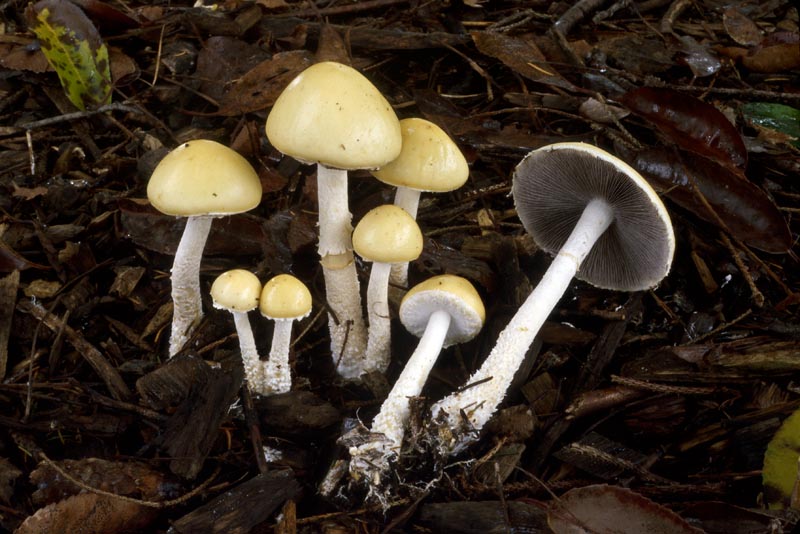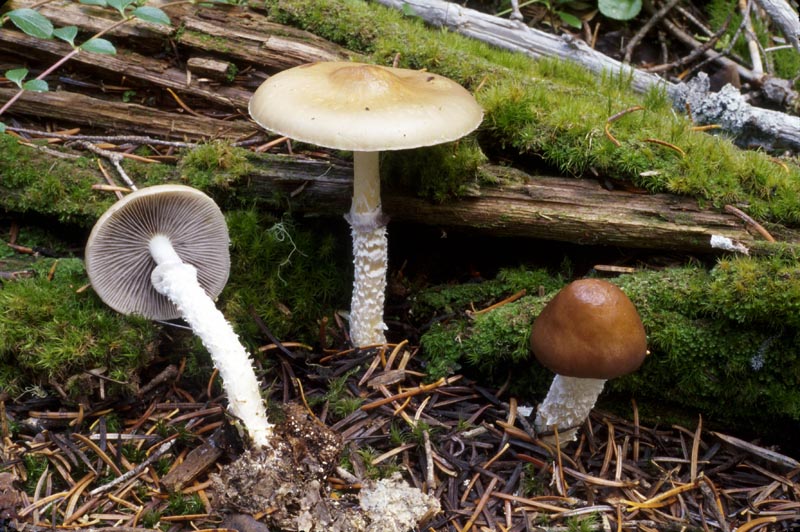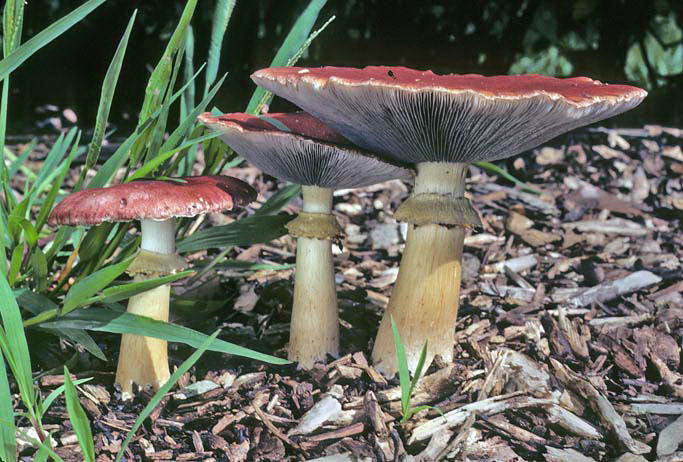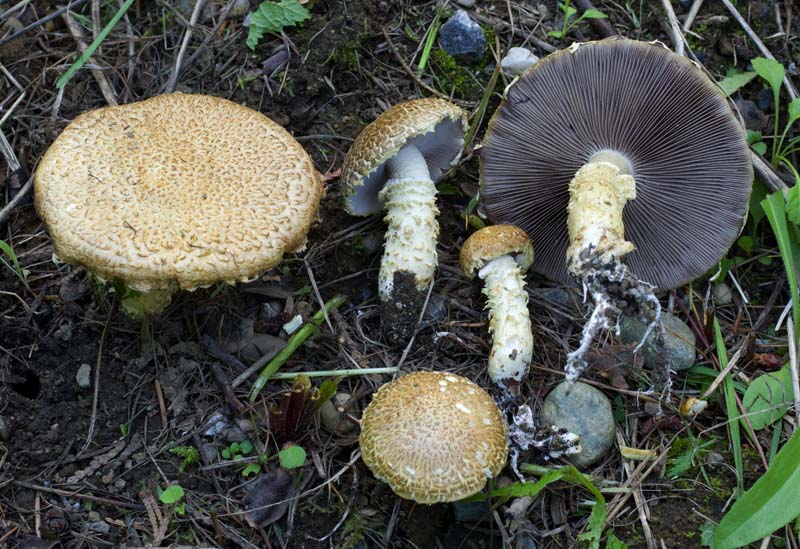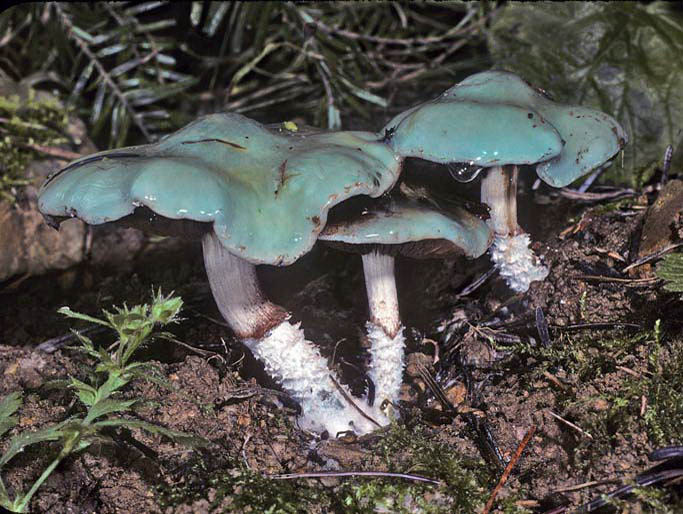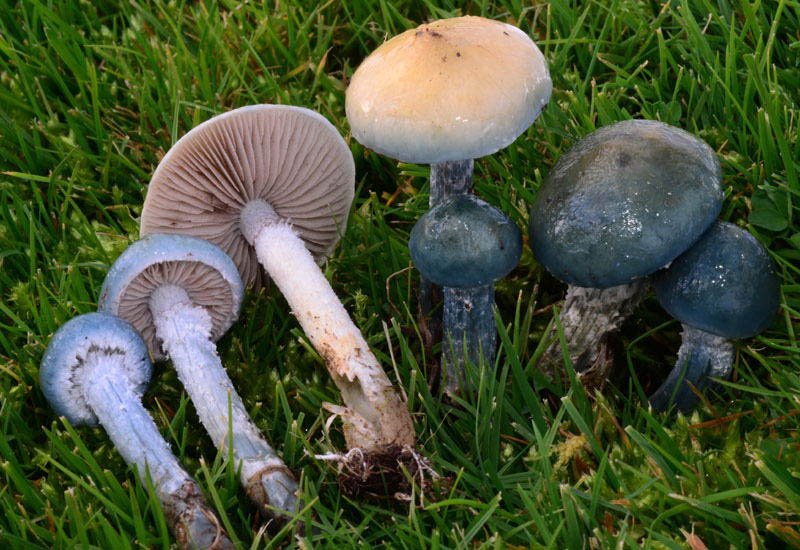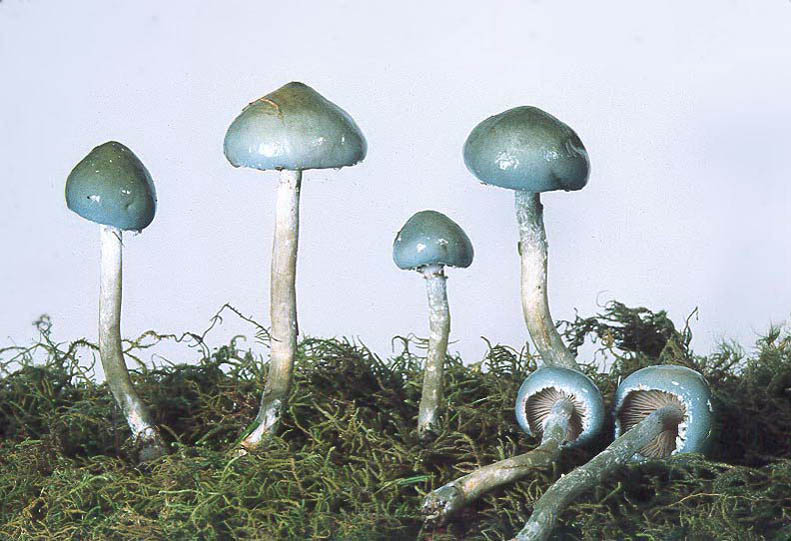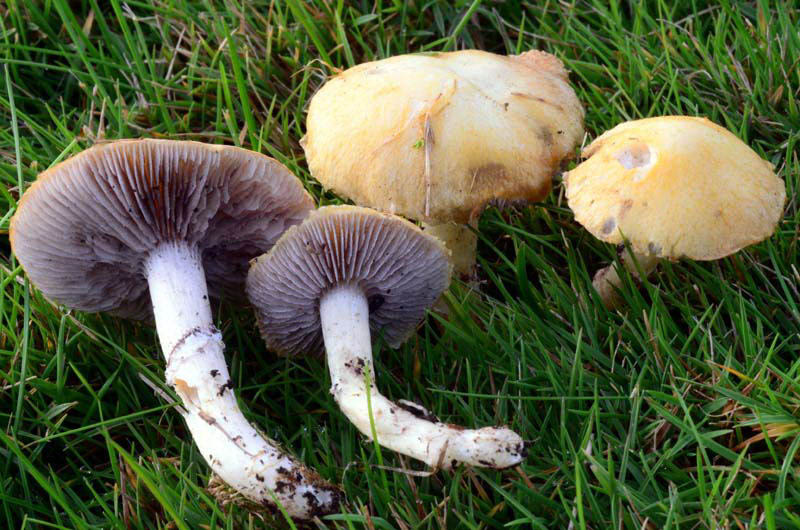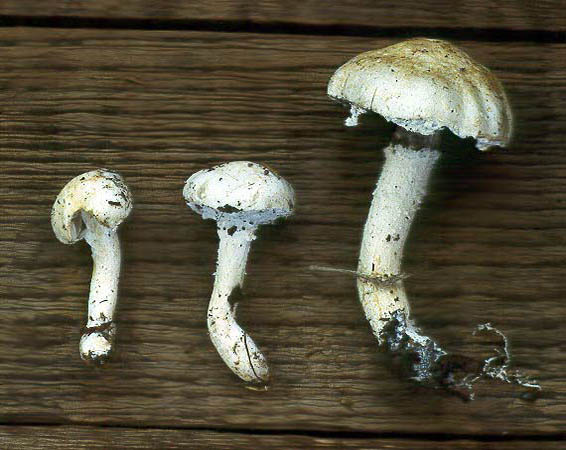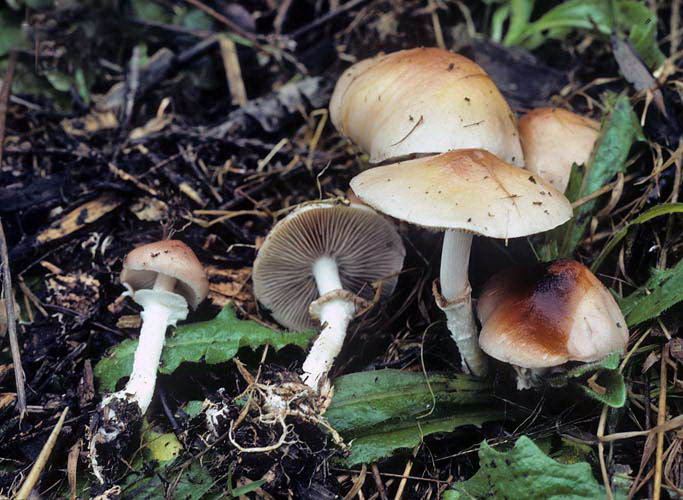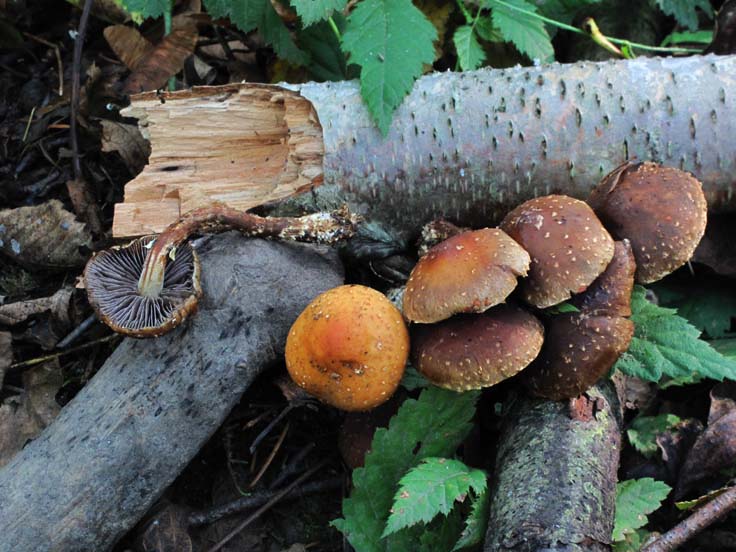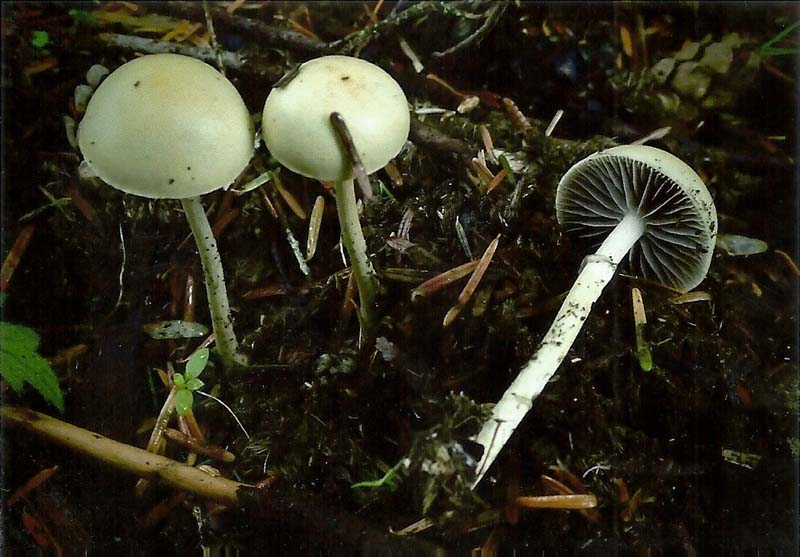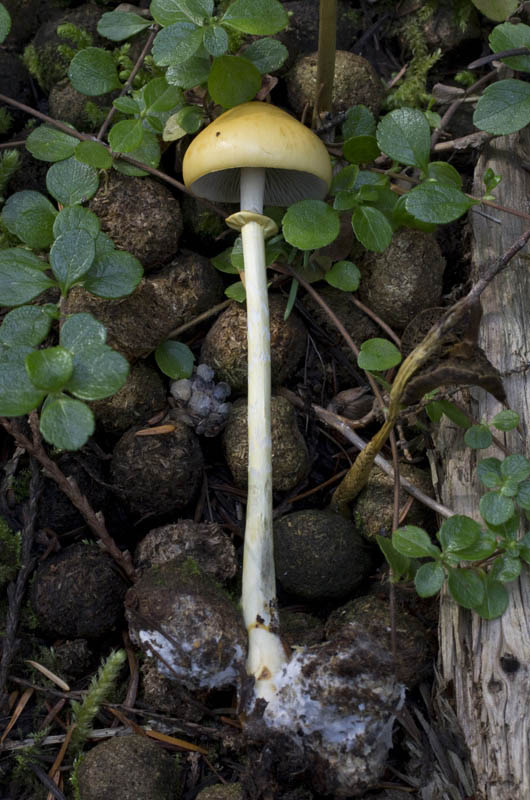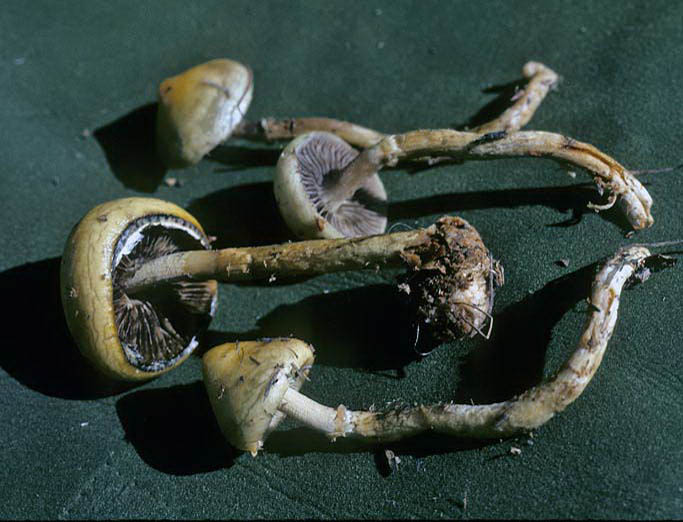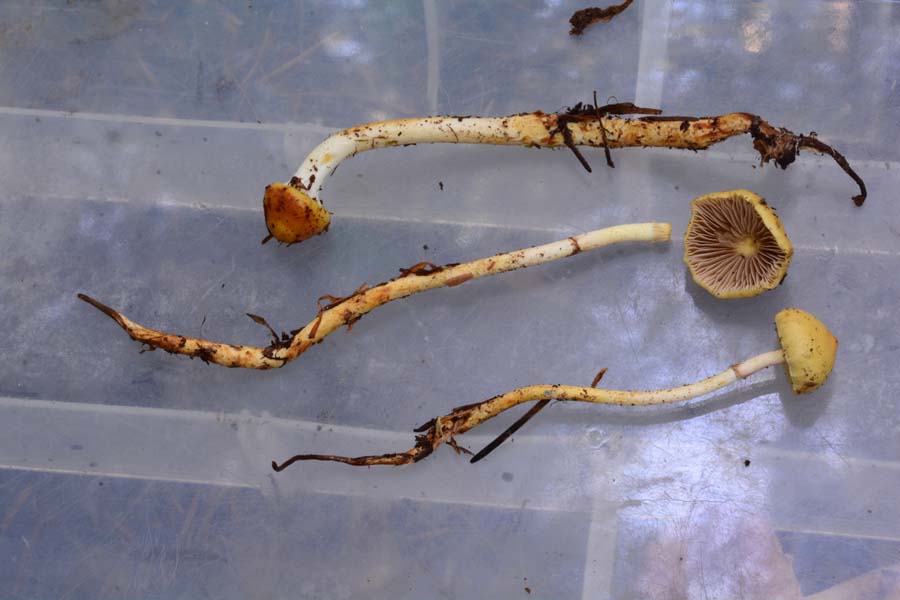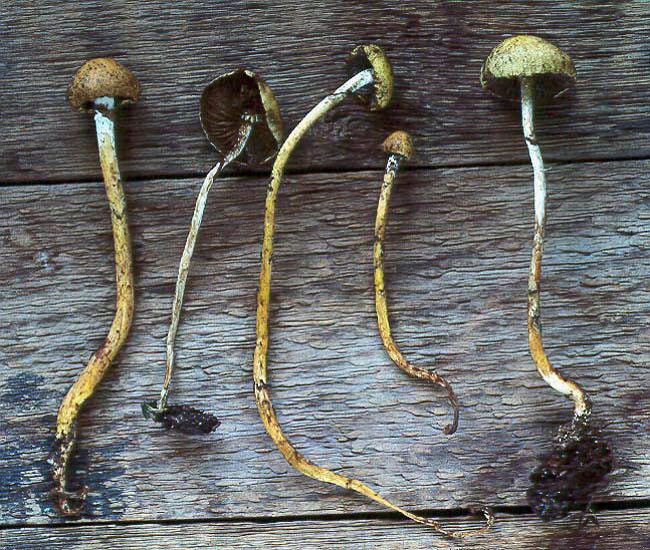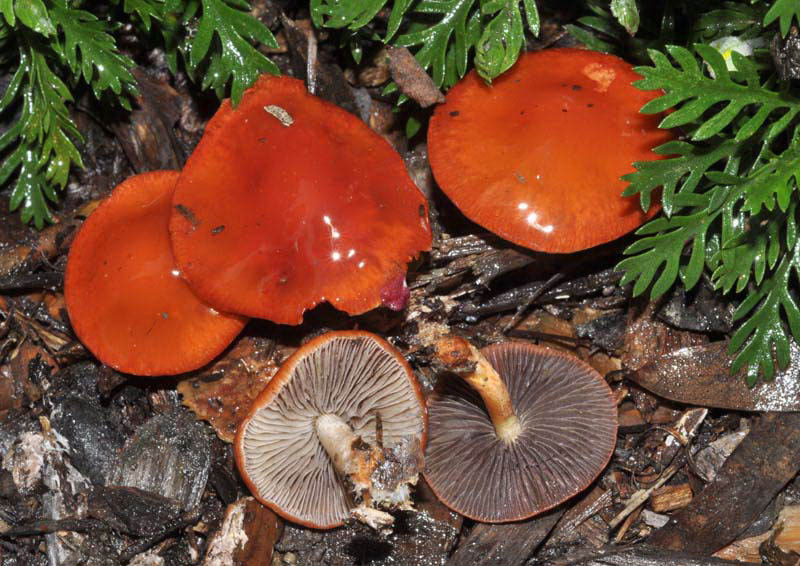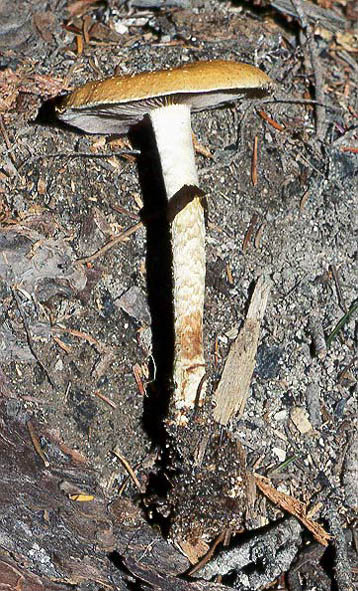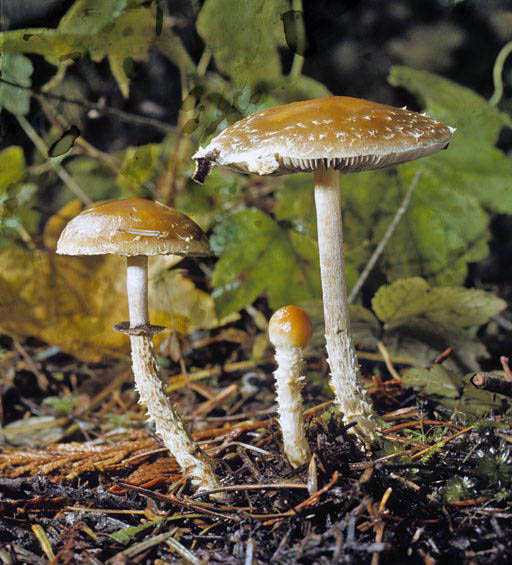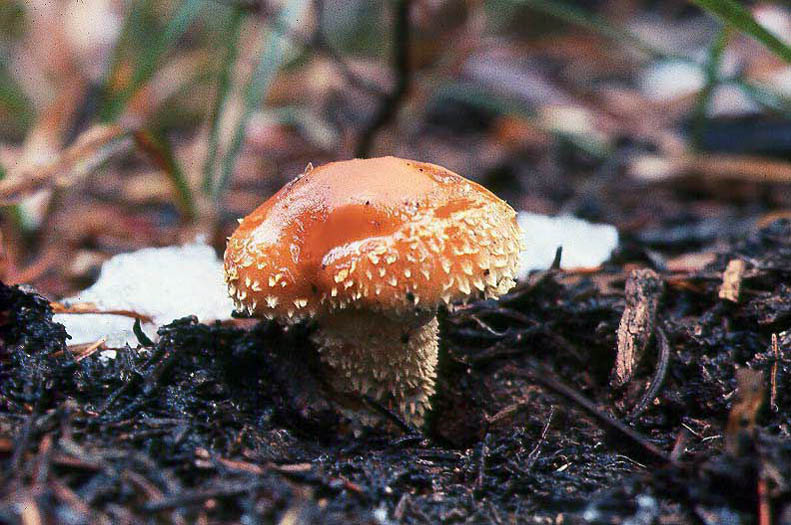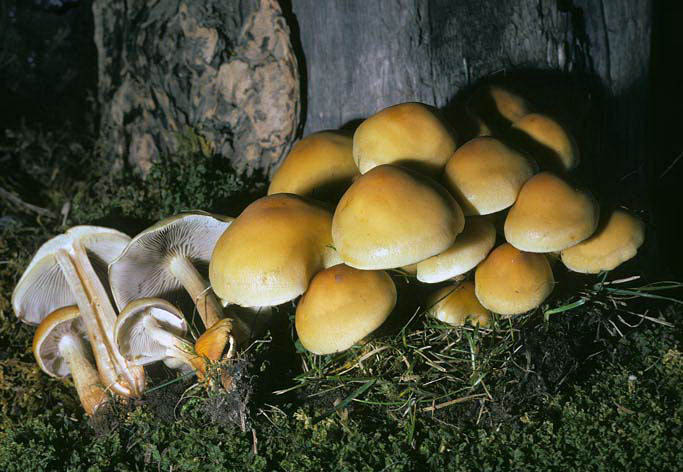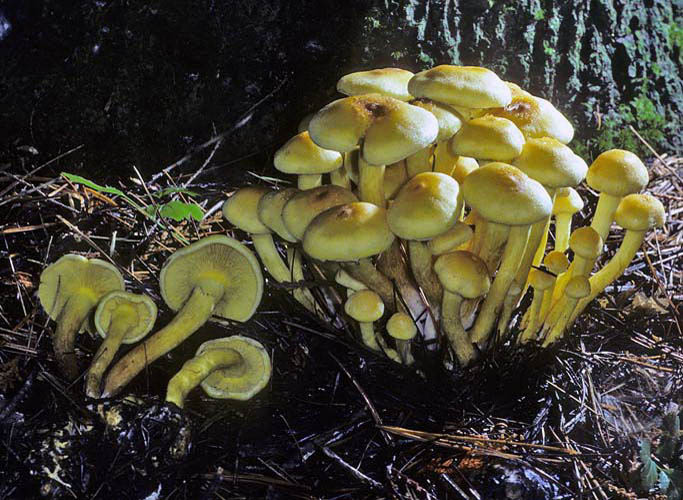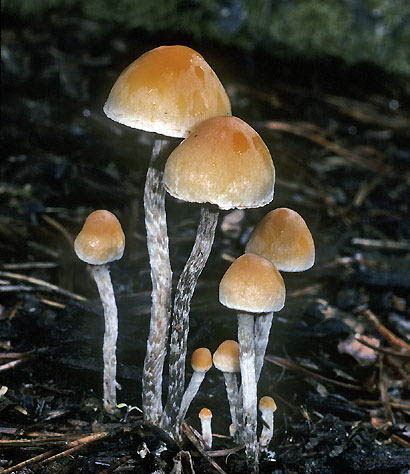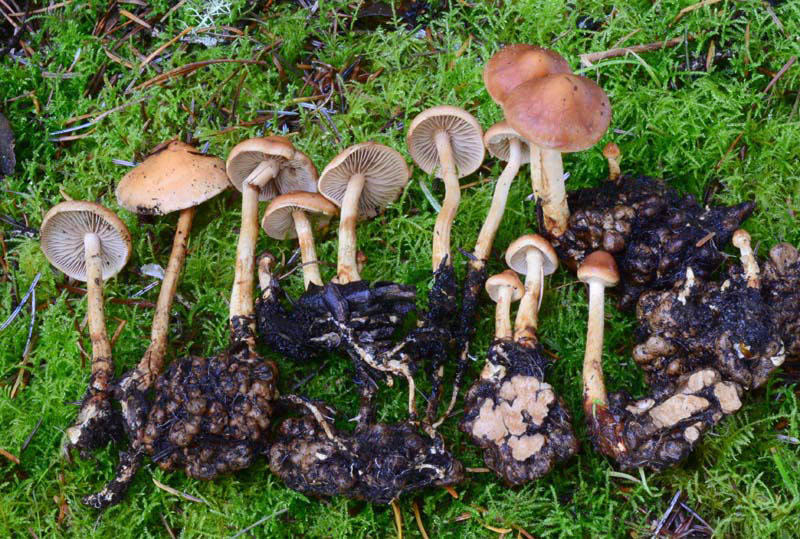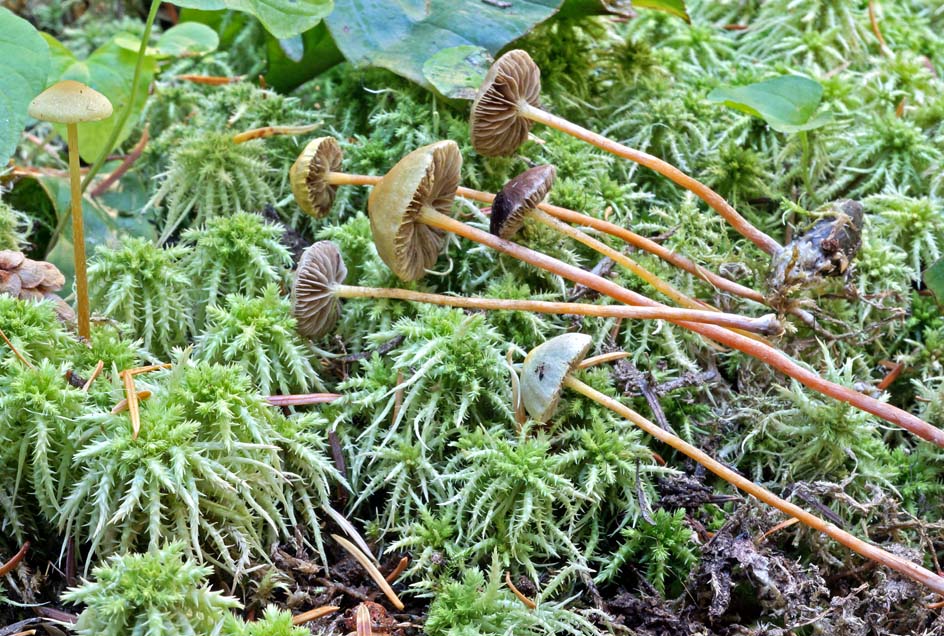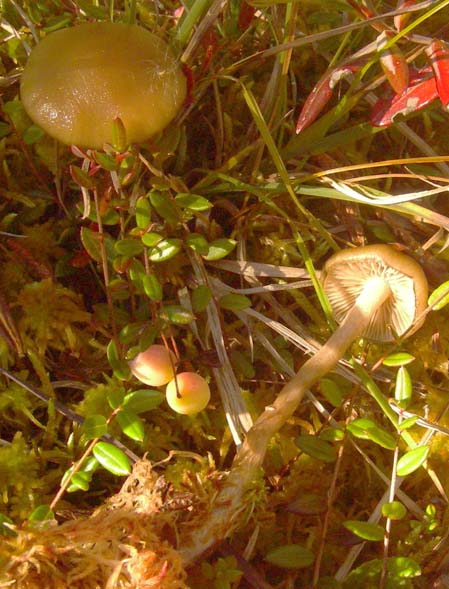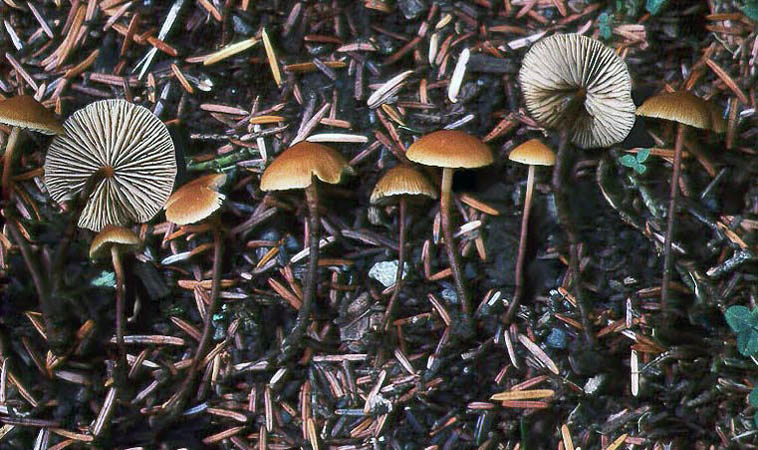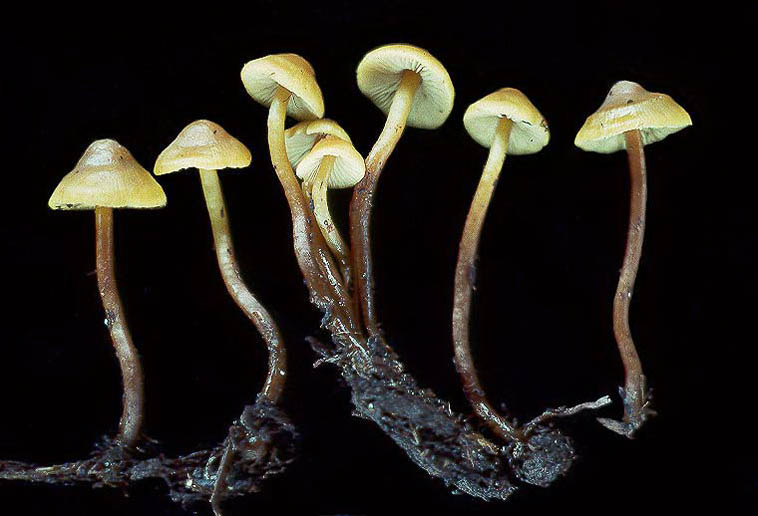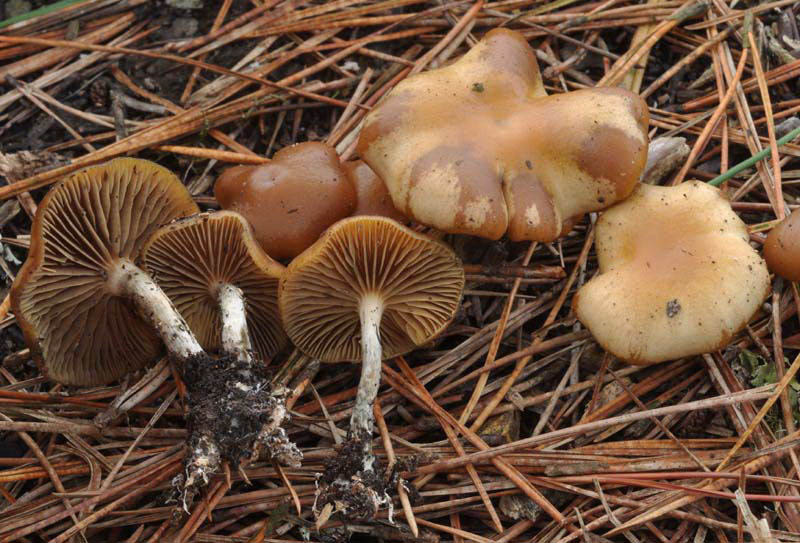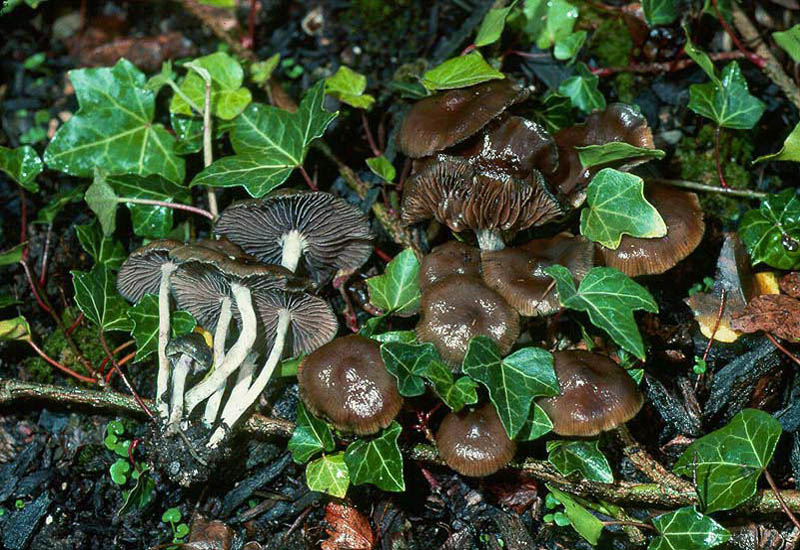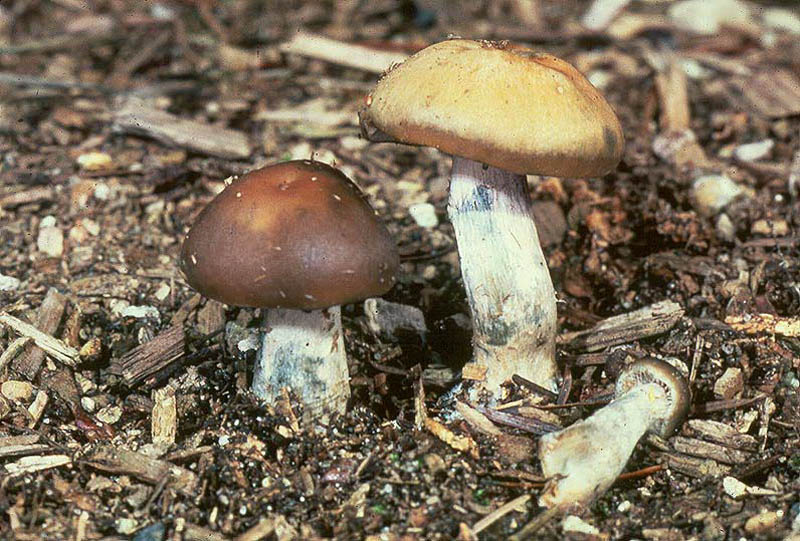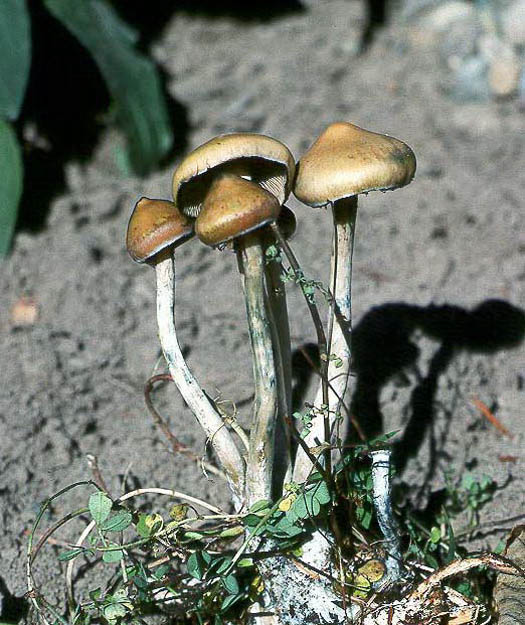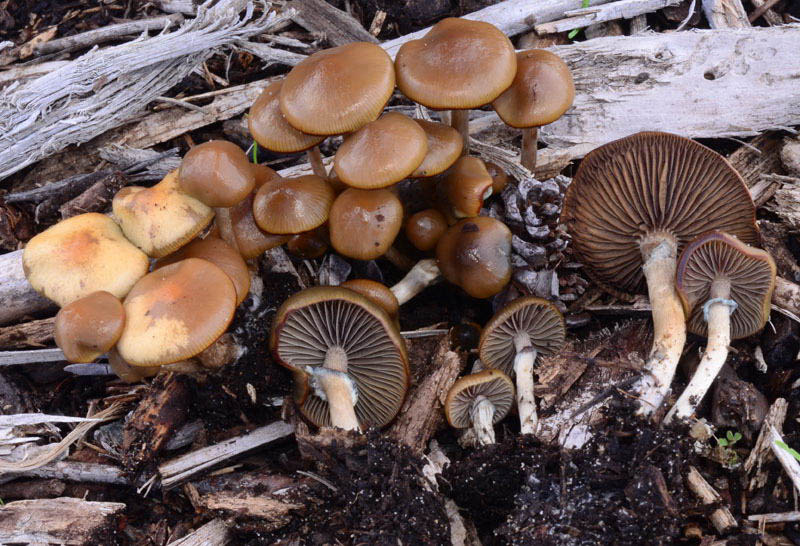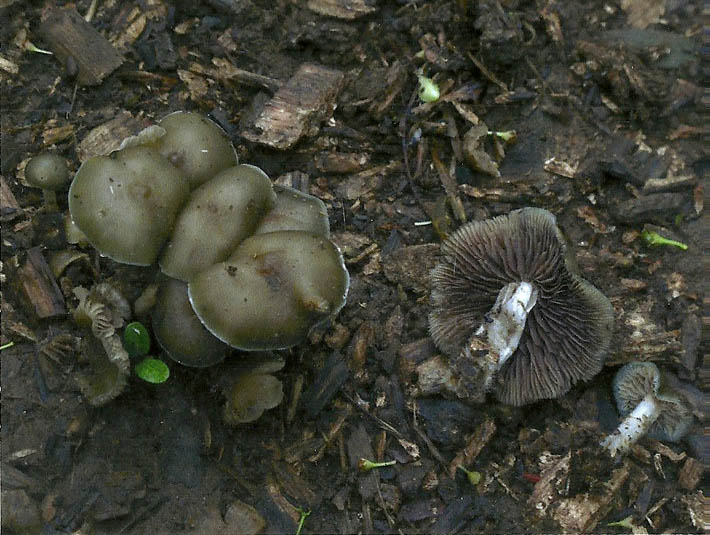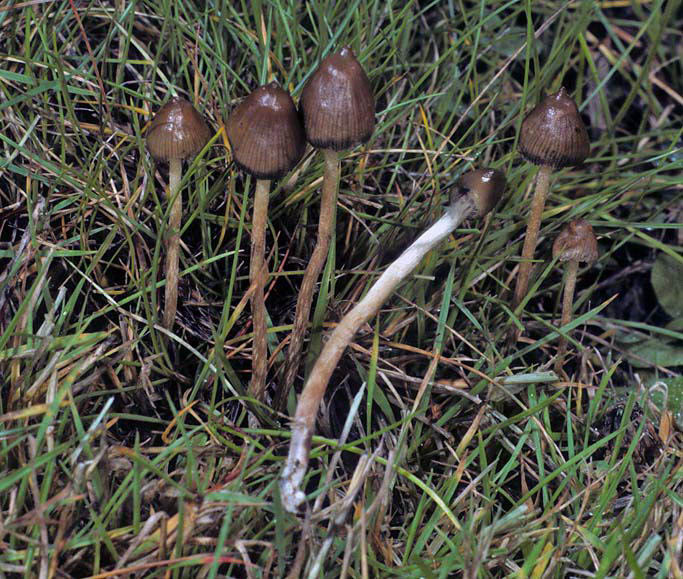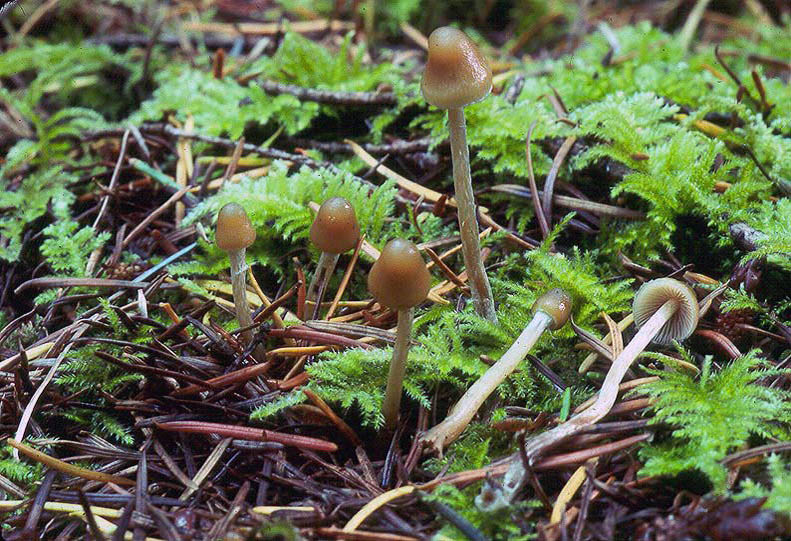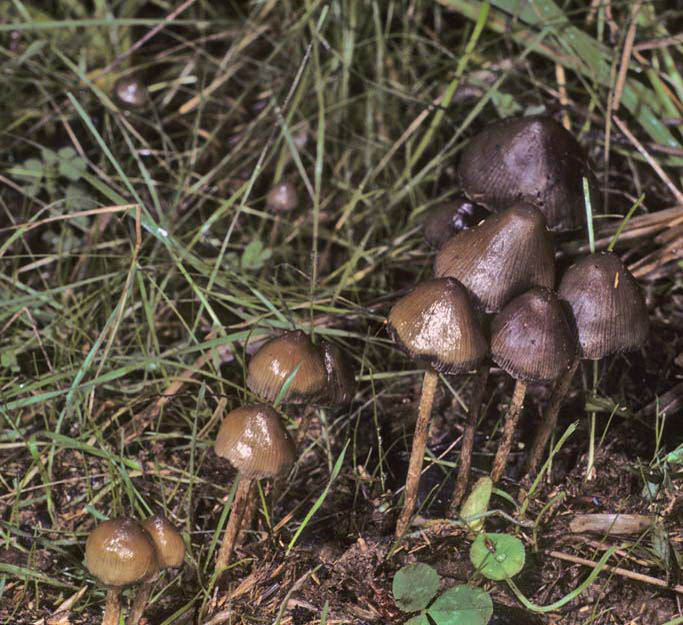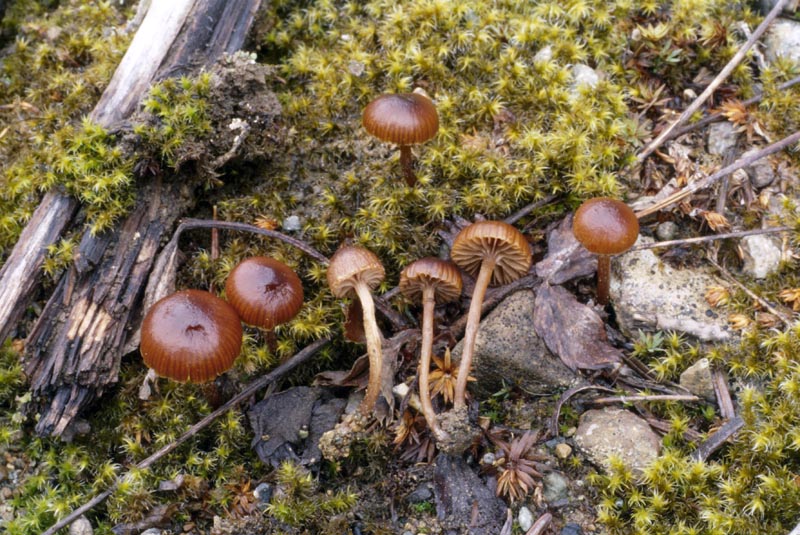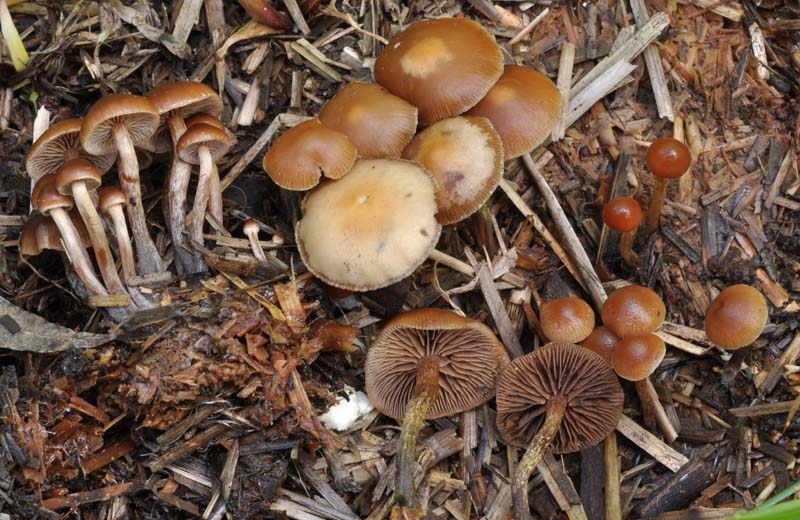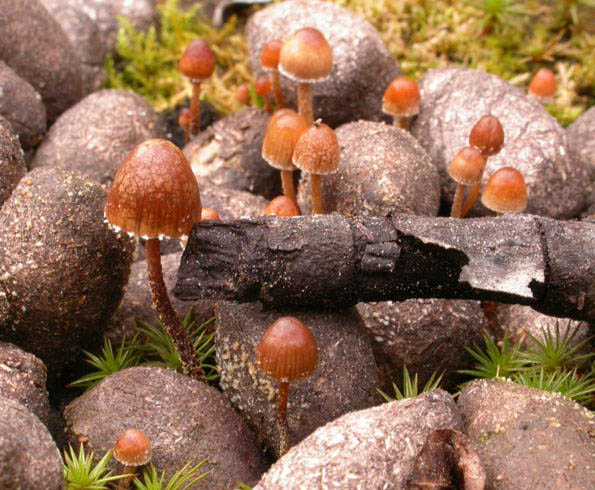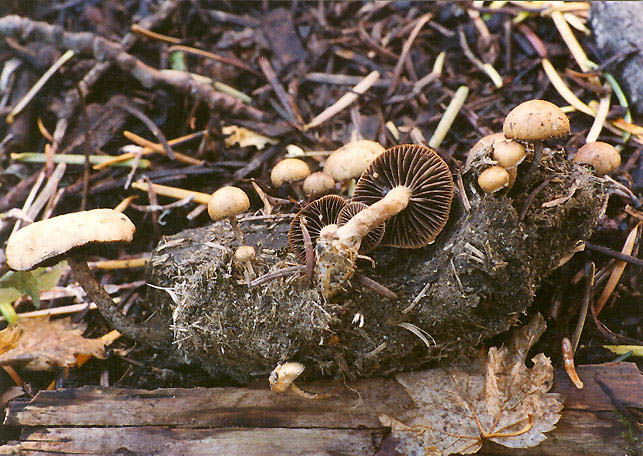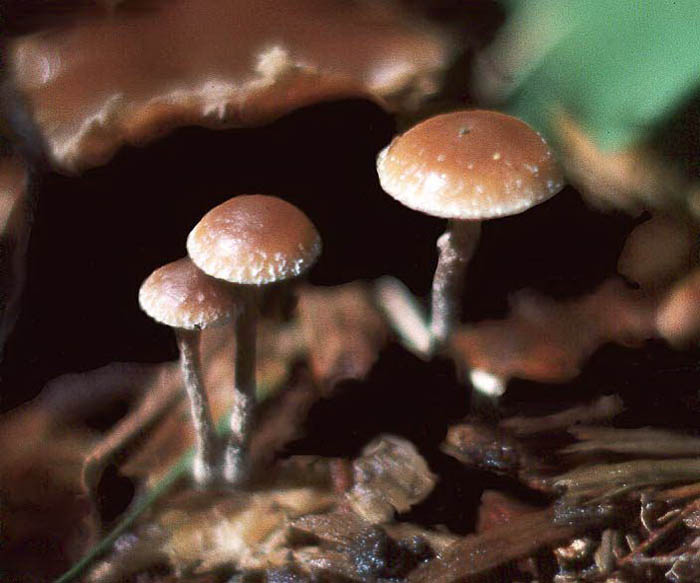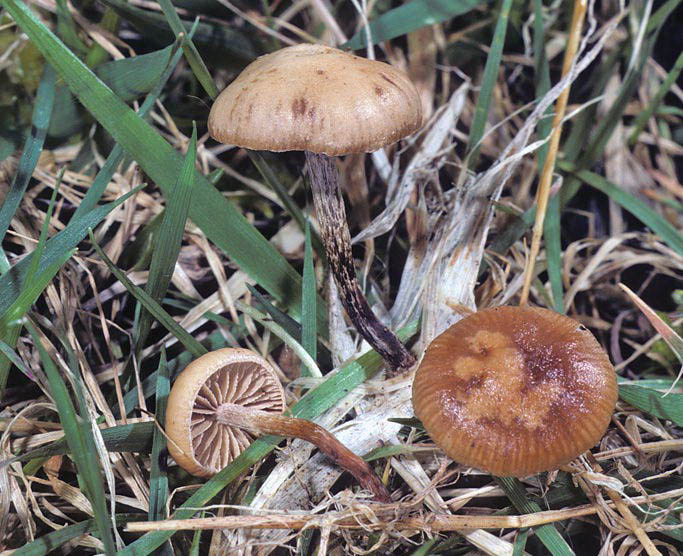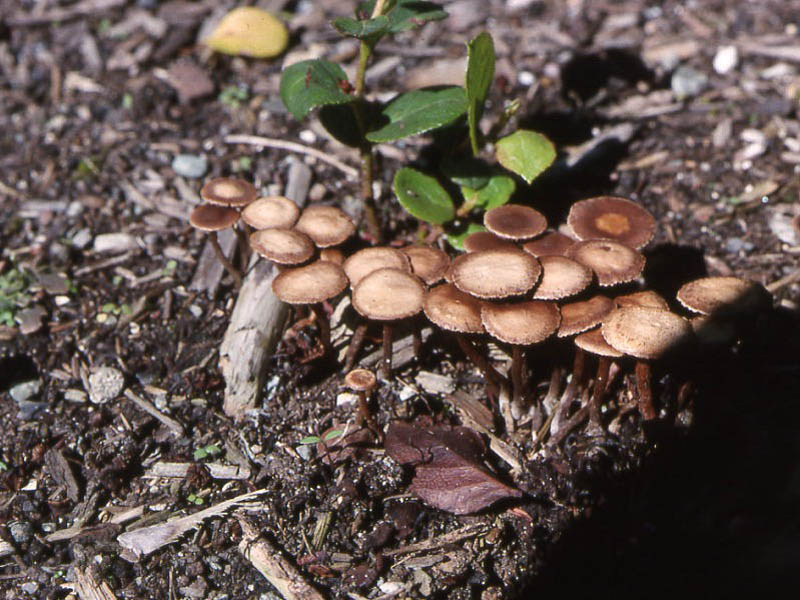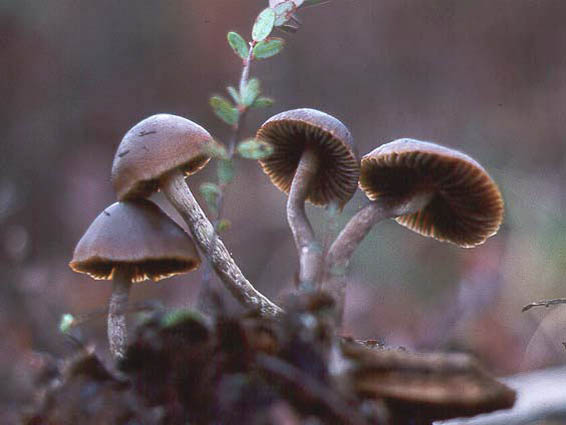Strophariaceae s.l.
These are all saprophytic. This page
describes those mushrooms obviously belonging to the Stropharia family (rather
dark brown spores or with a purple tint), others
like Pholiota and
Agrocybe with more "regular" brown spores are covered separately.
Mythicomyces/Stagnicola look like Stropharia but are
actually related to Psathyrella.
| A tiny "LBM" on fabric (or sometimes
wood) with a very dark spore print might be
Melanotus. |
Key to Strophariaceae:
- Stropharia s.l. - usually viscid,
colourful caps, but if not, larger or squatter than
other genera. Always a partial veil, not always leaving a ring.
- Psilocybe - viscid caps, small
to medium brown mushrooms that stain blue when handled.
- Deconica - viscid caps, small
brown mushrooms that do not stain blue.
- Hypholoma etc. - usually dry yellow-brown caps, small
to medium mushrooms. Phaeonematoloma is viscid with plainer
brown spores and hard to ID. Check Stropharia as well.
Stropharia - usually viscid cap,
not hygrophanous, usually found on the ground, dung or in grass (and
rarely on wood). They all have a partial veil, sometimes leaving a
ring and sometimes just leaving a ring zone. Usually medium to
large size (bigger than
Deconica). The smaller species that could be confused with Deconica have
a
hemispherical yellow cap, and similar Hypholomas
are not usually viscid. They are usually fairly colourful, with white
gill edges from the cystidia. The defining feature is the presence of
acanthocytes on the mycelium that might eat nematodes, but those are not easy to
detect.
S. ambigua - bright yellow cap, white fluffy veil
material everywhere (washes off) not present on the similar, smaller
Leratiomyces percevalii. No real ring, big, <15cm.
S. hornemannii - yellow-brown cap, fluffy stem,
ring. <12cm.
S. inuncta - this yellow-brown capped species usually has hints of grey and purple.
It has much smaller spores than S. hornemannii.
S. rugosoannulata - red cap fading to
yellow-brown, then hard to ID if you don't notice the smooth stem.
Ring. <15cm.
S. kauffmanii - scaly cap and stem, dry, yellow brown. Ring. <15cm.
S. scabella - dark red-brown cap.
S. aeruginosa - blue/green cap fading to pale yellow,
ring, white gill
edges. <6cm.
S. caerula - gill edges not white? Fades faster, less ring? <6cm.
S. pseudocyanea - smaller, <2cm, pointier
blue-green cap fading quickly to straw.
More study is needed to see which blues species are actually here. Our
most common one may be an undescribed sister species to S. cyanea.
S. coronilla - in grass, stocky with
yellow cap. Striate ring. <6cm.
S. albonitens - white cap with yellow tones. Ring. Fluffy
stem. <5cm. It looks just like a faded blue Stropharia, but is not
blue when fresh.
S. melanosperma - similar with much larger spores.
S. albivelata - warm
brown spore print, might be sought on that page. <8cm.
Red brown, ring.
Hemistropharia albocrenulata - large, viscid, red-orange, scaly cap
and stem, but found on wood so also keyed out with the
not-as-dark-spored Pholiota, mostly on
hardwood.
Protostropharia - These small, hemispherical yellow Stropharias with
long viscid stems in grass and
dung are unrelated and have been moved, or will be moved, to a new genus,
Protostropharia. They are all <5cm, but
Psilocybe and Deconica do not
have round yellow caps. Hypholoma is very similar, but
not usually viscid.
P. semiglobata grp (incl. P. dorispora) - in dung. Long viscid stem.
Similar to Agrocybe pediades.
<5cm.
P. alcis - one brightly coloured group member found on moose dung with a flaring
ring when young.
S. umbonatescens - pointy umbonate cap, resembling
Psilocybe but yellower.
S. semigloboides - yellow cap, even longer,
rooting viscid stem. Not in dung. Smaller, <1.5cm.
Much smaller spores.
S. silvatica - more brownish yellow than P. semigloboides?
Leratiomyces - another group recently separated from
Stropharia, containing several yellow to orange-red species. They are
only thinly viscid.
L. ceres (S. aurantiaca) - red-orange in gardens and wood chips.
Stem bruises reddish-orange. <5cm.
L. percevalii (riparius) - dull yellow, <9cm, smaller
than S. ambigua, no fluffy veil material, weak veil, smooth
stem.
L. magnivelaris - stronger ring?
Probably the same species.
L. 'squamosus' - small, <5cm, yellow with
shaggy stem and ring.
L. 'squamosus' var. thraustus - red-orange version.
<7cm.
Hypholoma - (formerly known as
Naematoloma) - non-viscid caps separate these from others in this
family (except for the viscid Phaeonematoloma), but still,
they can be very difficult to separate from Deconica and
Protostropharia. They have a very weak veil. The veil
is sometimes cobwebby like the cortina of
Cortinarius
and never leaves much material on the cap or stem. Often yellow-brown in colour.
Found on wood, moss, bogs or the ground. Some of the moss species have
paler spores than the others and could be searched for in the brown spored
pages. Not usually hygrophanous.
H. capnoides - grey young gills, clustered on
logs.
H. fasciculare - yellow-green young gills, bitter,
clustered on logs.
H. lateritium - brick red caps clustered on logs.
H. dispersum (marginatum) - on woody debris
on the ground, stiff, dark stem with white banding.
H. tuberosum - sclerotium (nutrient ball)
at the base of the stem, as in the paler spored
Agrocybe arvalis. But with a
cobweb veil and without white mycelium. A single nursery in Sydney
shipped peat around the world, spreading this Australian native
everywhere.
H. elongatum (elongatipes) - found in
Sphagnum moss, more yellowish cap than the
others? Somewhat hygrophanous.
Hypholoma udum (Bogbodia uda) - more olive to red-brown caps.
Hypholoma polytrichi/subericaceum - differ microscopically.
Phaeonematoloma myosotis - viscid cap and stem, plainer brown spores, olive brown, umbonate cap, in moss.
Mythicomyces/Stagnicola -
look like a cross between Hypholoma,
Xeromphalina and
Phaeocollybia, with dry caps.
Mythicomyces has dark spores like Hypholoma and a two-toned somewhat black horny stem like Xeromphalina.
Stagnicola is very similar with brown spores and might be looked for
in the LBMs. They resemble the Strophariaceae, but are
actually in the Psathyrellaceae. <2.5cm
across
Mythicomyces corneipes - hygrophanous.
Psilocybe - viscid capped
mushrooms mostly with a peelable cap cuticle, which can separate them
from Hypholoma, and
hygrophanous, which can separate
them from Stropharia. Small mushrooms (usually
<5cm
but sometimes bigger) that grow on the ground, grass, gardens or dung but
mostly in wood chips unless noted. They have a veil that is often
cobwebby like the cortina of Cortinarius that
may or may not leave a ring on the stem. They often smell
farinaceous. The larger ones can be mistaken for Stropharia but the
colour and shape is usually different. They are infamous for parts that can
stain blue-green due to the presence of psilocybin and psilocin, the
hallucinogenic substances that give these their nickname "magic
mushrooms". Psilocybin may also be found in some
Pluteus,
Conocybe, Inocybe,
Gymnopilus and
Panaeolus but by far most of the hallucinogenic species are found in
Psilocybe. The non-active species are called Psilocybe by some authors, but DNA
evidence has shown them not to be that closely related, so they are getting
their own genus,
Deconica. Unfortunately, you may have to admire these from a distance because
possession of anything that contains these substances in the U.S. is a federal
offense. People have died accidentally eating deadly poisonous lookalikes like
Galerina and Conocybe.
They are very difficult to tell apart.
P. cyanescens - caramel colour, wavy cap, <5cm.
P. baeocystis - similar, darker olive
when wet, incurved but not as wavy cap margin.
P. cyanofibrillosa/allenii - much like P. cyanescens, deep
chestnut drying light brown, veil leaves a faint ring zone. Less wavy cap.
P. azurescens - our largest, up to 10cm,
somewhat conical.
P. stuntzii - stem has a ring, <5cm.
P. ovoideocystidiata - similar with a weaker, wispy
ring.
P. semilanceata - conehead, mostly in grass,
<2.5cm. Similar to Stropharia umbonatescens.
P. strictipes - may not be distinct.
P. pelliculosa - similar but not as pointed, in
soil, <2.5cm.
P. subfimetaria/fimetaria - in dung in
grass, veil leaves a ring zone/ring on the stem, <2.5cm.
Deconica - very much like
Psilocybe, and once considered Psilocybe, but they
do not stain blue anywhere because they do not contain psilocybin, so they
have been (or will be) moved into Deconica. Viscid
capped, hygrophanous mushrooms
mostly with a peelable cap cuticle, which can separate them from
Hypholoma and
Stropharia. Small mushrooms (usually <2.5cm unless noted) that
grow on the ground, wood chips, grass, gardens or dung. They have a
veil that is often
cobwebby like the cortina of Cortinarius that
may or may not leave a ring on the stem. They are very difficult to tell apart,
so which species are here and how common they are is not well understood.
D. montana - in moss.
Possibly the least peelable cap cuticle. Low and high elevations.
D. coprophila/subcoprophila - found on dung.
D. angustispora (Psilocybe angustispora) - very similar, on dung,
much smaller <1cm. Not yet officially moved to Deconica.
D. merdaria/moelleri - on dung, with a
ring on the stem, <4cm.
D. crobula - in
forests, not on dung or moss. <4cm.
D. inquilina - in grass, possibly the same species,
<2cm.
D. apelliculosa/subviscida/phyllogena - very
similar, may or not be on dung, these species are especially
nondescript.
Psilocybe atrobrunnea (turficola) - often darker, in wet
places, <4cm. It has not been proven yet if this is a
Psilocybe or a Deconica.
